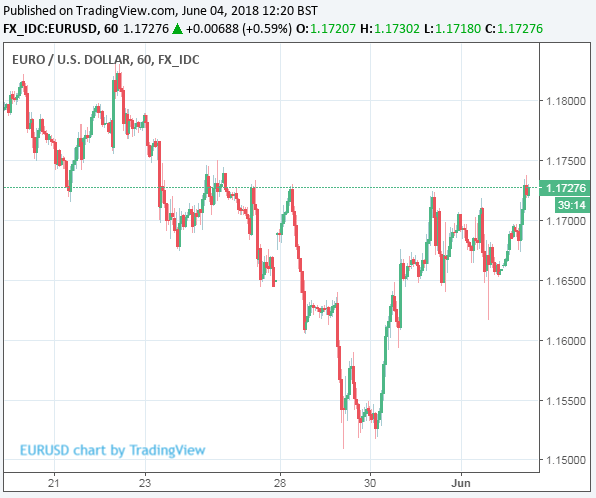EUR/USD Outlook Grows Murkier Still as Analysts Eye Italy and White House Trade Tariffs
- Written by: James Skinner
-
-Euro rebounds off 2018 lows as risk appetite returns to markets.
-ING Group, CIBC Capital Markets say EUR/USD has bottomed.
-BofAML says stay short, "trade war" catalyst for next leg down.

© thanasak, Adobe Stock
The Euro-to-Dollar rate continued to rebound off 2018 lows against the Dollar Monday but analysts remain divided over the exchange rate outlook, particularly now a renewed protectionist bent in White House trade policy has joined Italian politics at the top of agenda for markets.
Horse trading between two anti-establishment parties elected in Italy was seen placing the Mediterranean nation on a collision course with Brussels after its austerity policies were roundly rejected during talks to forge a coalition.
Fears of a possible Eurozone exit also resurfaced after it emerged the coalition may have discussed the hypothetical scenario of an exit from the single currency.
"We suspect EUR/USD seen its bottom at 1.1510 and is unlikely to re-test it this week. With the Italian political situation stabilising, the EZ risk premium should now be less of a negative driver of EUR/USD. Indeed, the risk premium already narrowed from 4% on Tuesday to 2.5% currently," says Petr Krpata, chief EMEA FX strategist at ING Group.

Above: Euro-to-Dollar rate shown at hourly intervals.
"Q2 2018 has been a wretched time to be a EUR bull. Going into this quarter, questions on the strength of the global growth theme hit the common currency hard," chimes Bipan Rai, North American head of FX strategy at CIBC Capital Markets. "EUR selling took on a more portentous tone once questions about Italy’s commitment to fiscal discipline and the EUR itself took hold. However, the bottom looks to be in place for EUR/USD."
However, no sooner than renewed fears over the Eurozone began to recede, the White House announced it would not renew an exemption for the European Union from tariffs on American imports of aluminium and steel.
This makes a retaliation highly likely and has placed the spectre of a so called trade war back on the agenda for markets once again. EU exports of steel and aluminium to the US are worth just more than €6 billion per year.
"Last week’s tariffs shouldn’t materially disrupt global growth, but the risk is that this situation cascades into something more nefarious. For that reason, talks between the US and China merit keeping an eye on. The negotiations over the weekend concluded with no statement – an indication that things are still murky," Rai adds.
Economists say the likely trade war between Europe, the United States and, potentially, China would hit economic growth in all affected geographies but particularly in Europe given the trade imbalance already heavily favours the EU. In other words, there are more European exports to the US that the White House could potentially levy tariffs on the vice versa.
"The US has decided to impose tariffs on EU imports of steel and aluminum. We would also expect threats for tariffs on European cars to continue," says Athanasios Vamvakidis, an FX strategist at Bank of America Merrill Lynch. "Things may get worse before getting better."
Above: Euro-to-Dollar rate shown at daily intervals.
President Donald Trump's decision to impose tariffs on EU exports of steel and aluminium to the US came just days after the White House said it has opened a section 232 investigation into the automotive sector, under the Trade Expansion Act 1962, with a view to establishing whether tariffs should also be levied on imported cars.
The section 232 investigation was the pretext initially use by the White House to bring about the steel and aluminium tariffs, one which took more than six months to reach its conclusion, so its deployment against the automotive sector has raised concerns among many analysts and economists.
The automotive industry is far more significant for the Eurozone economy than the steel or aluminium sectors, employing hundres of thousands of people and generating hundreds of billions of turnover each year.
Volkswagen AG, which is Europe and the world's largest carmaker, on its own makes sales to the US of more than €35 billion per year. Currently the US charges an import tariff of just 2.5% on cars from Europe whereas the EU charges a tariff of 10% on imports of American cars.
"We are concerned that the market has been focusing so much on Italy recently, that it may be ignoring the trade protection theme. This could be the next push for the Euro lower," Vamvakidis adds.
Vamvakidis and the BAML team have been betting on a fall in the value of the Euro relative to the Dollar ever since late April, when the EUR/USD rate was close to 1.24.
They are still targeting a downward move to 1.15, which is a level the exchange rate very nearly reached last week when concerns over Italian politics were in full swing.
Above: Euro-to-Dollar rate shown at weekly intervals.
Advertisement
Get up to 5% more foreign exchange by using a specialist provider to get closer to the real market rate and avoid the gaping spreads charged by your bank when providing currency. Learn more here
